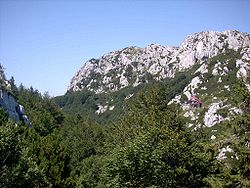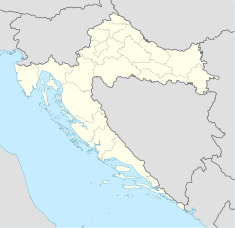Risnjak National Park
| Risnjak National Park | |
|---|---|
|
Native name Croatian: Nacionalni park Risnjak |
|

Hut below the summit of Risnjak in the National Park
|
|
| Location |
Primorje-Gorski Kotar County, |
| Coordinates | 45°25′42″N 14°44′42″E / 45.42833°N 14.74500°ECoordinates: 45°25′42″N 14°44′42″E / 45.42833°N 14.74500°E |
| Area | 63.5 km2 |
| Governing body | Risnjak National Park |
| Official name: Nacionalni park Risnjak | |
| Designated | 1949 |
Risnjak National Park (Croatian: Nacionalni park Risnjak) is a national park in Croatia. It is located in Gorski kotar, the most mountainous and heavily forested region of the country, about 15 km inland from the Adriatic Sea. The park covers an area of 63.5 square kilometers including the central part of Risnjak and Snježnik massif and the source area of the river Kupa. The administration and visitor center of the park are located in Crni Lug, a town on the eastern edge of the park.
The name of the massif probably comes from the Croatian word for the lynx, ris. Another interpretation suggests that it comes from the local word risje, which is a name for a type of grass.
The first recorded scientific visit was made in 1825 by the Budapest botanist Joseph Standler. Many other botanists visited subsequently. The most prominent 19th century explorer of Risnjak was the botanist Josip Schlosser who wrote numerous publications about Risnjak and its flora. The first organized mountaineering visit was mounted by the Rijeka alpine club, and the first mountain refuge in the area was built in 1932.
In 1949 botanist Ivo Horvat suggested for the first time that the area around Risnjak should be protected. On his advice, the parliament of the then Socialist Republic of Croatia declared 36.00 km2 around Risnjak to be a national park. In 1956 the area of the park was reduced to 30.14 km2, of which 21.06 km2 were put under stricter protection. Finally, in 1997, the Croatian parliament voted to enlarge of the park to its current size. The areas of Snježnik and Kupa source were added to the park but also for the first time inhabited areas of villages of Razloge, Razloški okrug and Krašćevica.
...
Wikipedia

